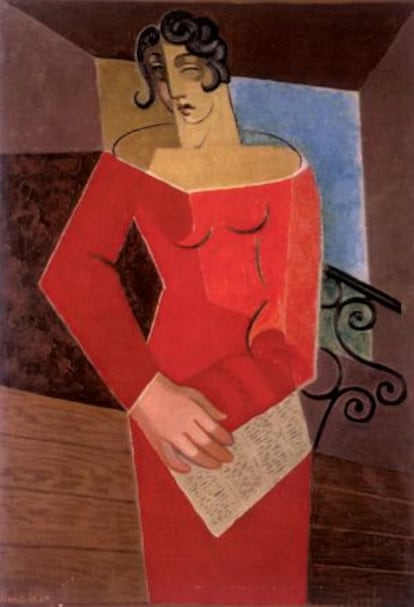On the trail of Juan Gris
Some painters, given over to the material aspects of their art, like to let on that literature is a closed book to them

In the grey December of Madrid, about the hottest color is the red dress of a woman painted by Juan Gris. Gris went off to Paris in 1906, at the age of 19, not so much to paint as just to get away from the conscription that would have sent him off to the war in Morocco. As fugitives do, he gave himself another name, and then shortened it to Juan Gris, which suitably smacked of Cubism.
The Cubist movement that Picasso and Braque had founded became, for Juan Gris, a permanent esthetic home. After a few years Braque drifted off into decorative painting, while Picasso's immense energy led him toward expansion, rather than persistence or concentration. Juan Gris had a much shorter life than Picasso or Braque, and thus less time to change; but besides, he had a sort of innate obstinacy, that peculiar kind of talent that thrives on concentration, and finds strength in rigid limits.
His back was turned to a Spain that was hostile to modern art, and he saw himself as an heir to a French tradition that went from Chardin to Cézanne. But the photos show a sturdy Spanish face, a serious masculinity, almost Caribbean in its coarseness, and his painting reflects the simplicity, more evangelical than ascetic, of the still-lifes of Sánchez Cotán, or the earthenware-laden tables of the young Velázquez.
Gris's talent thrived on concentration and found strength in rigid limits
Some painters, given over to the material aspects of their art, like to let on that literature is a closed book to them. Juan Gris read a good deal of contemporary work in both French and Spanish, and many of his later works were book illustrations. In a letter to Vicente Huidobro, written in that French-contaminated Spanish that grew on him with the years, he says: "The more an image is based on something common or vulgar, the more force and poetry it has."
Juan Gris died at 40, in 1927, unknown in Spain and with his Cubism already going out of fashion in France. In another letter he writes: "People are enthused with displays of chaos, but no one wants discipline and clarity."
Now the red-dressed woman is on Madrid billboards, and one of the pleasures of the fall is in spotting them around the city. Who, you think, is going to notice Juan Gris, beside Picasso and Braque? Yet he possesses "the purity of heart of desiring one single thing," in the words of Kierkegaard: the capacity for working one small field and staying with it, as did Thelonious Monk or Emily Dickinson.
The red-dress poster announces the Fundación Telefónica's Cubist exhibition, where there are a few Juan Gris pictures that take your breath away, plunging you into hypnotic contemplation. The greys and earthen tones of Picasso explode in the red of Juan Gris's Singer, with her curls echoing the tight forms of her dress, and the iron curlicues of the balcony behind her. The window may open on the sea, or on a suggestion of hills. In the Fundación Telefónica a measured light allows the colors to speak for themselves, in the clarity of a room that one seems to be looking right in to.
The more it's based on common or vulgar things, the more force it has"
From the Telefónica showing you take a little more than half-an-hour to reach the other window on Juan Gris now open in Madrid, which is in the room exclusively devoted to him in the Reina Sofía. The waves of the sea are sinuous white lines on a blue identical to the color of the sky. A sailboat, a mere white triangle. The strings of the guitar, the lines of a book and those of a newspaper, and the striations in the wood of the table, echo one another with assonant rhymes.
But this is not the end of the trail. In the Fundación Lázaro Galdiano there is now a Juan Gris drawing, belonging to the collection of Leandro Navarro; beside it, a drawing by Morandi. They are surely together on purpose. A few years ago the curator, Lola Jiménez-Blanco, edited the letters of Juan Gris. To sit in the garden of the Lázaro Galdiano and read them is a good way of continuing along the trail.
Colección Cubista de Telefónica. Fundación Espacio Telefónica. Gran Vía, 28. Madrid. Coleccionismo al cuadrado. Fundación Lázaro Galdiano. Serrano, 122. Madrid. Until January 7.
Tu suscripción se está usando en otro dispositivo
¿Quieres añadir otro usuario a tu suscripción?
Si continúas leyendo en este dispositivo, no se podrá leer en el otro.
FlechaTu suscripción se está usando en otro dispositivo y solo puedes acceder a EL PAÍS desde un dispositivo a la vez.
Si quieres compartir tu cuenta, cambia tu suscripción a la modalidad Premium, así podrás añadir otro usuario. Cada uno accederá con su propia cuenta de email, lo que os permitirá personalizar vuestra experiencia en EL PAÍS.
¿Tienes una suscripción de empresa? Accede aquí para contratar más cuentas.
En el caso de no saber quién está usando tu cuenta, te recomendamos cambiar tu contraseña aquí.
Si decides continuar compartiendo tu cuenta, este mensaje se mostrará en tu dispositivo y en el de la otra persona que está usando tu cuenta de forma indefinida, afectando a tu experiencia de lectura. Puedes consultar aquí los términos y condiciones de la suscripción digital.









































